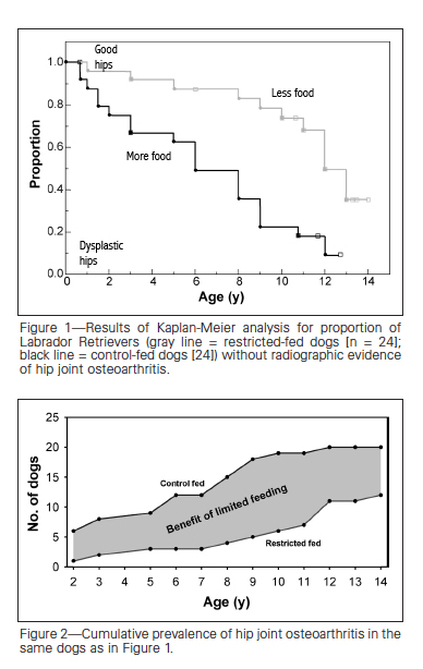There is probably no other non-lethal health problem except perhaps allergies that afflicts so many breeds of dogs as hip dysplasia. It cripples dogs with pain, sometimes in the prime of their lives, and there is very little modern veterinary care can do about it. It seems clear that it has some genetic component (it is thought to be polygenic) but there are clearly environmental (i.e., non-genetic) influences as well. There has been some modest success in reducing its incidence in some breeds by screening programs, but for the most part it remains an intractable problem and the focus of many research programs.
Consequently, I was quite surprised to run across a paper (1) published in 2006 about a study that was able to substantially reduce in incidence and severity of hip dysplasia in Labradors – not by locating particular genes or implementing strategically-designed breeding programs – but by reducing food consumption. (Download a copy here - pdf) Conducted by Nestle Purina in collaboration with a slate of veterinarians and academics, the study used 48 Labrador Retriever puppies from 7 litters. In each litter, puppies were paired and one assigned to the control group and one to the treatment group. The control group was provided food ad libitum (unrestricted) starting at 8 weeks, and each puppy in the treatment group was fed 25% less than the amount consumed by its pair in the control group. Their weight was monitored and hips x-rayed at regular intervals throughout the lifetimes of the dogs.

Dogs allowed to eat as much as they wanted showed evidence of hip dysplasia at younger ages than dogs fed less, and the difference between the groups got worse as they got older. By 6 years of age, 50% of dogs in the unlimited food group had evidence of osteoarthritis, compared with only 10% of dogs in the restricted food group. More than 50% of the dogs in the restricted food group still had radiographically normal hips at 12 years old; in the other group, 90% were arthritic. Dogs fed 25% less food than their pair in the control group weighed about 25% less throughout their lives. Heavier dogs had worse hips.
I was astonished to see these results. By any scientific, medical, or veterinary standard, the effect of diet restriction on incidence of osteoarthritis in Labradors would be considered profound. If somebody was to submit a grant proposal to test a treatment that promised to reduce the incidence of hip dysplasia in dogs – not by 10%, or even 25%, but 50% – I should hope it would receive very serious consideration for funding. And what about the Canine Health Foundation and also the Orthopedic Foundation for Animals (OFA), which owes its founding to concern about the high incidence and crippling effects of hip dysplasia in dogs? A browse of the information on their websites about the disease makes no mention of this study or the potential benefits of lifelong food limitation. I showed this paper to a few breeders. Most were surprised to see these data. Some breeders, especially of large breeds, said they managed food intake of their puppies so they didn’t grow to fast, but they were worried about growth rate and not adult body weight.
“Less Food” - such a simple (and cost-effective!) way to substantially reduce the suffering of dogs, reduce veterinary bills for treatment, x-rays, and pain relief, and increase the amount of time the family dog can continue to lead an active life. Millions of dollars are spent every year looking for sources and cures of disease in dogs so that we can offer them better lives. Maybe we should direct some of this funding to an informational public service campaign to get this simple information to breeders and pet owners, and perhaps also some clear recommendations on dog food bags, maybe even brochures in veterinary offices.
I mentioned up top that there was also most certainly some genetic component to development of hip dysplasia, and that’s certainly worth talking about because there might be some surprises there as well. Getting back to genetics, I’ll be addressing those in another post.
In the meantime, I’m taking a pound or two off my dog.
(1) Smith, GK, ER Paster, MY Powers, DF Lawler, DN Biery, FS Shofer, PJ McKellvie & RD Kealy. 2006. Lifelong diet restriction and radiographic evidence of osteoarthritis of the hip joint in dogs.
*** Population Genetics for Dog Breeders ***
Next class starts 30 March 2015
Visit our Facebook Groups
ICB Institute of Canine Biology
...the latest canine news and research
ICB Breeding for the Future
...the science of animal breeding

